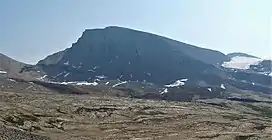| Mistaya Mountain | |
|---|---|
 Northwest aspect | |
| Highest point | |
| Elevation | 3,078 m (10,098 ft)[1][2] |
| Prominence | 366 m (1,201 ft)[3] |
| Parent peak | Mount Baker (3180 m)[3] |
| Listing | |
| Coordinates | 51°42′41″N 116°35′06″W / 51.71139°N 116.58500°W[4] |
| Geography | |
 Mistaya Mountain Location in Alberta and British Columbia  Mistaya Mountain Mistaya Mountain (British Columbia) | |
| Country | Canada |
| Provinces | Alberta and British Columbia |
| Protected area | Banff National Park[1] |
| Parent range | Waputik Mountains[3] |
| Topo map | NTS 82N10 Blaeberry River[4] |
| Climbing | |
| First ascent | July 21, 1933 by H.S. Kingman, J. Monroe Thorington, C. Kain[5][3] |
Mistaya Mountain is located on the border of Alberta and British Columbia, on the Continental Divide. It was named in 1918.[1][3] Mistaya is either the Cree name for "grizzly bear"[6] or is the Stoney word for "much wind".[7]
Mistaya is an easyish, non-technical mountain with good views, especially to the north, north-west and south.
Geology
Mistaya Mountain is composed of sedimentary rock laid down during the Precambrian to Jurassic periods. Formed in shallow seas, this sedimentary rock was pushed east and over the top of younger rock during the Laramide orogeny.[8]
Climate
Based on the Köppen climate classification, Mistaya Mountain is located in a subarctic climate zone with cold, snowy winters, and mild summers.[9] Temperatures can drop below −20 °C (−4 °F) with wind chill factors below −30 °C (−22 °F).
Gallery
See also
References
- 1 2 3 "Mistaya Mountain". cdnrockiesdatabases.ca. Retrieved 2019-08-25.
- ↑ "Topographic map of Mistaya Mountain". opentopomap.org. Retrieved 2021-10-11.
- 1 2 3 4 5 "Mistaya Mountain". Bivouac.com. Retrieved 2019-08-26.
- 1 2 "Mistaya Mountain (AB)". Geographical Names Data Base. Natural Resources Canada. Retrieved 2019-08-26.
- ↑ Thorington, J. Monroe (1966) [1921]. "Kicking Horse Pass to Howse Pass". A Climber's Guide to the Rocky Mountains of Canada. With the collaboration of Putnam, William Lowell (6th ed.). American Alpine Club. p. 146. ISBN 978-1376169003.
- ↑ Fromhold, Joachim (2012). 2001 INDIAN PLACE NAMES OF THE WEST, Part 2: Listings by Nation. ISBN 9781300389118. Retrieved 2019-08-26.
- ↑ Boles, Glen W.; Laurilla, Roger W.; Putnam, William L. (1990). Place Names of the Canadian Alps. Revelstoke, B.C.: Footprint Publishing. p. 200. ISBN 0-9691621-4-6.
- ↑ Gadd, Ben (2008). Geology of the Rocky Mountains and Columbias.
- ↑ Peel, M. C.; Finlayson, B. L.; McMahon, T. A. (2007). "Updated world map of the Köppen−Geiger climate classification". Hydrol. Earth Syst. Sci. 11: 1633–1644. ISSN 1027-5606.
External links

